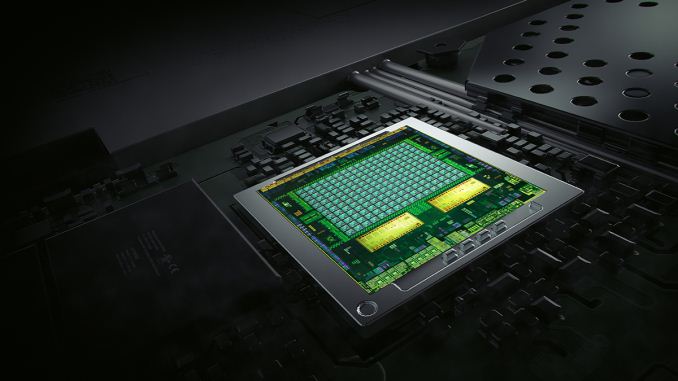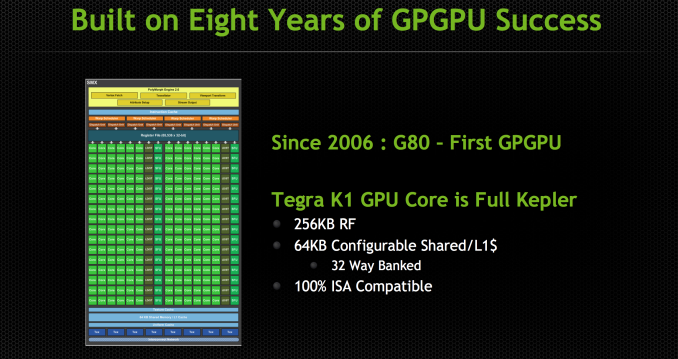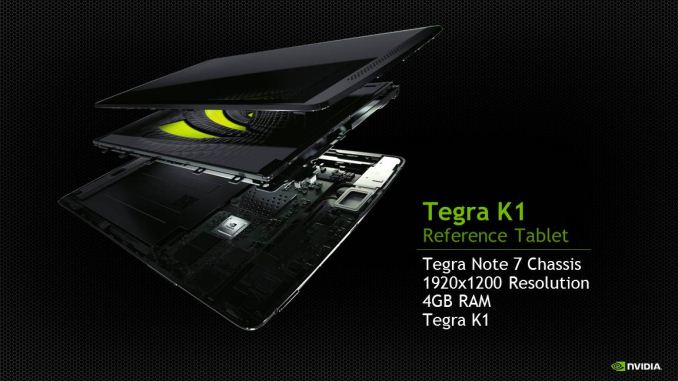NVIDIA Tegra K1 Preview & Architecture Analysis
by Brian Klug & Anand Lal Shimpi on January 6, 2014 6:31 AM ESTFinal Words
NVIDIA’s challenge with Tegra has always been getting design wins. In the past NVIDIA offered quirky alternatives to Qualcomm, most of the time at a more attractive price point. With Tegra K1, NVIDIA offers a substantial feature and performance advantage thanks to its mobile Kepler GPU. I still don’t anticipate broad adoption in the phone space. If NVIDIA sees even some traction among Android tablets that’s enough to get to the next phase, which is trying to get some previous generation console titles ported over to the platform.
NVIDIA finally has the hardware necessary to give me what I’ve wanted ever since SoC vendors first started focusing on improving GPU performance: the ability to run Xbox 360 class titles in mobile. With Tegra K1 the problem goes from being a user interface, hardware and business problem to mostly a business problem. Android support for game controllers is reasonable enough, and K1 more or less fixes the hardware limitations, leaving only the question of how do game developers make enough money to justify the effort of porting. I suspect if we’re talking about moving over a library of existing titles that have already been substantially monetized, there doesn’t need to be all that much convincing. NVIDIA claims it’s already engaged with many game developers on this front, but I do believe it’ll still be an uphill battle.
If I were in Microsoft’s shoes, I’d view Tegra K1 as an opportunity to revolutionize my mobile strategy. Give users the ability to run games like Grand Theft Auto V on a mobile device in the not too distant future and you’ve now made your devices more interesting to a large group of users. I don’t anticipate many wanting to struggle to play console games on a 5-inch touchscreen, but with a good controller dock (or tablet with a kickstand + wireless controller) the interface problem goes away.
For the first time I’m really excited about an NVIDIA SoC. It took the company five generations to get here, but we finally have an example of NVIDIA doing what it’s really good at (making high performance GPUs) in mobile. NVIDIA will surely update its Tegra Note 7 to a Tegra K1 version (most of its demos were run in a Tegra Note 7 chassis), but even if that and Shield are the best we get the impact on the rest of the market will be huge. With Tegra K1, NVIDIA really raised the bar on the GPU performance.
The CPU side, at least for the Cortex A15 version is less interesting to me. ARM’s Cortex A15, particularly at high clocks, has proven to be a decent fit for tablets. I am curious to see how the Denver version of Tegra K1 turns out. If the rumors are true, Denver could very well be one of the biggest risks we’ve seen taken in pursuit of building a low power mobile CPU. I am eager to see how this one plays out.

Finally: two big cores instead of a silly number of tiny cores
NVIDIA hasn’t had the best track record of meeting shipping goals on previous Tegra designs. I really hope we see Tegra K1, particularly the Denver version, ship on time (although I'm highly doubtful this will happen - new custom CPU core, GPU and process all at the same time?). I’m very eager not only for an install base of mobile devices with console-class GPUs to start building, but also to see what Denver can do. I suspect we’ll find out more at GTC about the latter. It’s things like Tegra K1 that really make covering the mobile space exciting.












88 Comments
View All Comments
eddman - Monday, January 6, 2014 - link
I'm wondering the same thing.Xbox and PS are gaming machines, running specialized OSes, and programmers can utilize low-level APIs and extract as much performance as possible.
Tegra K1 might be powerful, but it'll still be running general purpose OSes like android and windows RT.
Is there any way to know the performance gain by going low-level vs. high-level APIs for a video game? How much it really is? 5%? 15%? 40%?!!
Krysto - Monday, January 6, 2014 - link
Xbox360 and PS3 support DirectX9 and OpenGL ES 2.0+extensions. Many developers can and have made games with those APIs. Not all games on the consoles are "bare metal". So the "overall" difference in gaming, is probably not going to be very different.The real "problem" is that, those games will need to come to devices that have 1080p or even 2.5k resolutions, which will cut the graphics performance of the games by 2-4x, compared to Xbox/PS3. This is why I hate the OEMs for being so dumb and pushing resolutions even further on mobile.
It's a waste of component money (could be used for different stuff instead), of battery life, and also of GPU resources.
nicolapeluchetti - Monday, January 6, 2014 - link
I guess really good games use low levels API, i mean GTA V looks amazing and the specs of the X-Box 360 are what they are.I agree with you that resolution will be a problem, but actually i really like the added resolution in everyday use. i recently switched from a note 2 to a nexus 5 and the extra resolution is fantastic.
They will probably have to upscale things, render at 720p and render at 1080p
Krysto - Tuesday, January 7, 2014 - link
AMD said Mantle is pretty much bare-metal console API. And they said at their conference at CES that Battlefield 4 with that is 50 percent faster. So the difference is not huge, but significant.By far the biggest impact will be made by the resolution of the device. While games on Xbox 360 run at 720p, most devices with Tegra K1 will probably have at least a 1080p resolution, which is twice as many pixels, so it cuts the performance in half (or the graphics quality).
TheJian - Sunday, January 12, 2014 - link
Link please, and at what point in the vid do they say it (because some of those vids are 1hr+ for conferences)? I have seen only ONE claim and by a single dev who said you might get 20% if lucky. It is telling that we have NO benchmarks yet.But I'm more than happy to read about someone using Mantle actually saying they expect 45-50% IN GAME over a whole benchmark (not some specific operation that might only be used once). But I don't expect it to go ever 20%.
Which makes sense given AMD shot so low with their comment of "we wouldn't do it for 5%". If it was easy to get even 40% wouldn't you say "we wouldn't do it for 25%"? Reality is they have to spend to get a dev to do this at all, because they gain NOTHING financially for using Mantle unless AMD is paying them.
I'll be shocked to see BF4 over 25% faster than with it off (I only say 25% for THIS case because this is their best case I'm assuming, due to AMD funding it big time as a launch vehicle). Really I might be shocked at 20% but you gave me such a wide margin to be right saying 50%. They may not even get 20%.
Why would ANY dev do FREE work to help AMD, and when done be able to charge ZERO over the cost of the game for everyone else that doesn't have mantle? It would be easier to justify it's use if devs could charge Mantle users say $15 extra per game. But that just won't work here. So you're stuck with amd saying "please dev, I know its more work and you won't ever make a dime from it, but it would be REALLY nice for us if you did this work free"...Or "Hi, my name is AMD, here's $8 Million dollars, please use Mantle". Only the 2nd option works at all, and even then you get Mantle being back burner the second the game needs to be fixed for the rest of us (BF4 for instance, all stuff on back burner until BF4 is fixed for regular users). This story is no different than Phsyx etc.
nicolapeluchetti - Tuesday, January 7, 2014 - link
Mantle is said to have 45% performance bonus compared to DirectX on Battlfield. Those are the rumours.OreoCookie - Monday, January 6, 2014 - link
It's great to see that finally the SoC makers are being serious about GPU compute, now it's up to software developers to take advantage of all that compute horsepower. Given Apple's focus on GPU performance in the past, I'm curious to see what their A8 looks like and how it stacks up against Tegra K1 (in particular the Denver version).timchen - Monday, January 6, 2014 - link
The Denver speculation really needs some justification.Doesn't common sense say that the same task is always more power efficient done with hardware rather than software? It would at least need a paragraph or two to explain how OoO or speculative execution or ILC can be more power efficient in software.
Now if it is just that you need to build different binaries specifically for these cores, it then sounds a lot more like a compute GPU actually-- but as far as I understand so far general tasks are not suitable to run on those configurations, and parallelization for general problems is pretty much a dead horse (similar to P=NP?) now.
KAlmquist - Monday, January 6, 2014 - link
That speculation didn't make a lot of sense to me, either.One of the reasons that out of order execution improves performance is that cache misses are expensive. In an out of order processor, when a cache miss occurs the processor can defer the instructions that need that particular piece of data, and execute other instructions while waiting for the read to complete. To create "nice bundles of instructions that are already optimized for peak parallelism," you have to know how long each memory read is going to take.
The writers mention the Transmeta Efficeon processor, which translated x86 instructions to native instructions and then executed them on an in-order processor. That was a fairly effective approach, but doesn't demonstrate that an in-order processor can compete with a modern out of order processor. After all, ARM started out producing in-order processors, which were very energy efficient, but eventually they had to produce an out of order design in order to increase performance without increasing the clock rate.
Loki726 - Monday, January 6, 2014 - link
Transmeta didn't have an in-order design in the same way that a normal CPU is in order. See their CGO paper: http://people.ac.upc.edu/vmoya/docs/transmeta-cgo....Here's the relevant text:
"Compilers typically deal with recovery from speculation by generating compensation code, which re-
executes incorrectly sequenced operations, performs operations omitted from the speculative code path, and
corrects mismatches in register assignments (Freudenberger et al. [13]). With this approach, hardware
support is required to defer faults of potentially faulting instructions moved above branches (e.g.,
boosting,Smith et al. [23]), to detect overlapping memory operations scheduled out of sequence, and to branch to the
compensation code (e.g., memory conflict buffers, Gallagher et al. [14], or the Intel IA-64 ALAT[18]).
In contrast, Crusoe native VLIW processors provide an elegant hardware solution that supports arbitrary kinds of
speculation and subsequent recovery and works hand-in-hand with the Code Morphing Software [8]. All registers
holding x86 state are shadowed; that is, there exist two copies of each register, a working copy and a shadow
copy. Normal atoms only update the working copy of the register. If execution reaches the end of a translation, a
special commit operation copies all working registers into their corresponding shadow registers, committing the
work done in the translation. On the other hand, if any exceptional condition, such as the failure of one of CMS’s
translation assumptions, occurs inside the translation, the runtime system undoes the effects of all molecules
executed since the last commit via a rollback operation that copies the shadow register values (committed at the
end of the previous translation) back into the working registers.
Following a rollback, CMS usually interprets the x86 instructions corresponding to the faulting translation, executing
them in the original program order, handling any special cases that are encountered, and invoking the x86
exception-handling procedure if necessary.
Commit and rollback also apply to memory operations. Store data are held in a gated store buffer, from which they
are only released to the memory system at the time of a commit. On a rollback, stores not yet committed can
simply be dropped from the store buffer. To speed the common case of no rollback, the mechanism was designed so
that commit operations are effectively “free”[27], while rollback atoms cost less than a couple of branch mispredictions."